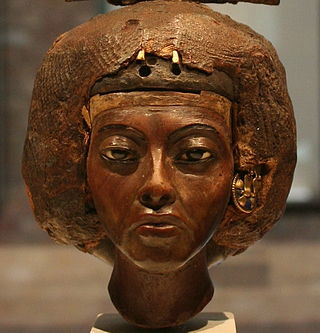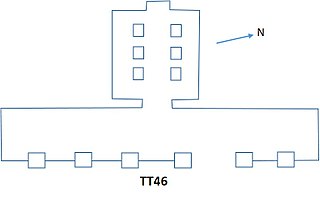
Ipy, also transliterated as Apy, was a court official from the time of Amenhotep III and Akhenaten during the Egyptian 18th Dynasty. Ipy was High Steward of Memphis, and a royal scribe.

Ipy, also transliterated as Apy, was a court official from the time of Amenhotep III and Akhenaten during the Egyptian 18th Dynasty. Ipy was High Steward of Memphis, and a royal scribe.
Ipy came from a family of well-known court officials. He was the son of Amenhotep (Huy), the High steward of Memphis and his wife May, and he was the grandson of the Mayor of Memphis Heby. The Vizier Ramose was an uncle of Ipy. [1]
Ipy succeeded his father sometime after the first Heb-Sed festival of Amenhotep III. He appears in the tomb of his uncle Ramose at the end of the reign of Amenhotep III when he has taken over his father's duties. [2] He continued in office under Akhenaten, and eventually did not just work in Memphis, but was a presence in Akhetaten as well. [1]
In Akhenaten's year five Ipy wrote a report to the King reporting that both state and temple properties in Memphis were faring well. After that Ipy became the Overseer of the inner palace of pharaoh in Akhetaten. Ipy is known to have had a house in this city as well. [2]

According to Dodson Ipy had a tomb prepared in Thebes, namely TT136. This tomb is said to have included four images of Akhenaten in an Osirian pose. [1] However Ipy was never residing in Thebes, making it unlikely that he was the owner of this tomb. [3]
Ipy may have also had a tomb prepared in Amarna. This tomb is now known as tomb 10. The tomb is small and unfinished. [4] William C. Hayes questions the identification of the Ipy from Amarna with the Ipy from Memphis based on the lack of titles borne by the Amarna official. [5] Ipy is only given the titles of royal scribe and steward. The tomb contains typical elements such as a copy of the Great Hymn to the Aten and scenes of the royal family worshipping the Aten. Akhenaten and Nefertiti are for instance shown offering votive items – cartouches of the Aten flanked by small statue(s) – to the Aten. Meritaten, Meketaten and Ankhesenpaaten are shown behind their parents shaking sistra. [4]
Martin mentions a tomb for Ipy in Memphis. This tomb has not been located however. [6] The tomb is likely located not far from the tomb of his father Amenhotep (Huy). Two of Ipy's canopic jars were found by Giovanni Anastasi, and are now in the Rijksmuseum van Oudheden in Leiden. [5] A relief from his Memphite tomb appeared before 2011 on the art market. [7]

Aten, also Aton, Atonu, or Itn was the focus of Atenism, the religious system formally established in ancient Egypt by the late Eighteenth Dynasty pharaoh Akhenaten. Exact dating for the Eighteenth Dynasty is contested, though a general date range places the dynasty in the years 1550 to 1292 BCE. The worship of Aten and the coinciding rule of Akhenaten are major identifying characteristics of a period within the Eighteenth Dynasty referred to as the Amarna Period.

Amarna is an extensive ancient Egyptian archaeological site containing the remains of what was the capital city during the late Eighteenth Dynasty. The city of Akhetaten was established in 1346 BC, built at the direction of the Pharaoh Akhenaten, and abandoned shortly after his death in 1332 BC. The name that the ancient Egyptians used for the city is transliterated as Akhetaten or Akhetaton, meaning "the horizon of the Aten".

Akhenaten, also spelled Akhenaton or Echnaton, was an ancient Egyptian pharaoh reigning c. 1353–1336 or 1351–1334 BC, the tenth ruler of the Eighteenth Dynasty. Before the fifth year of his reign, he was known as Amenhotep IV.

Nefertiti was a queen of the 18th Dynasty of Ancient Egypt, the great royal wife of Pharaoh Akhenaten. Nefertiti and her husband were known for their radical overhaul of state religious policy, in which they promoted the earliest known form of monotheism, Atenism, centered on the sun disc and its direct connection to the royal household. With her husband, she reigned at what was arguably the wealthiest period of ancient Egyptian history. After her husband's death, some scholars believe that Nefertiti ruled briefly as the female king known by the throne name, Neferneferuaten and before the ascension of Tutankhamun, although this identification is a matter of ongoing debate. If Nefertiti did rule as Pharaoh, her reign was marked by the fall of Amarna and relocation of the capital back to the traditional city of Thebes.

Tiye was the Great Royal Wife of the Egyptian pharaoh Amenhotep III, mother of pharaoh Akhenaten and grandmother of pharaoh Tutankhamun; her parents were Yuya and Thuya. In 2010, DNA analysis confirmed her as the mummy known as "The Elder Lady" found in the tomb of Amenhotep II (KV35) in 1898.

Amenhotep III, also known as Amenhotep the Magnificent or Amenhotep the Great and Hellenized as Amenophis III, was the ninth pharaoh of the Eighteenth Dynasty. According to different authors, he ruled Egypt from June 1386 to 1349 BC, or from June 1388 BC to December 1351 BC/1350 BC, after his father Thutmose IV died. Amenhotep was Thutmose's son by a minor wife, Mutemwiya.

Atenism, also known as the Aten religion, the Amarna religion, and the Amarna heresy, was a religion in ancient Egypt. It was founded by Akhenaten, a pharaoh who ruled the New Kingdom under the Eighteenth Dynasty. The religion is described as monotheistic or monolatristic, although some Egyptologists argue that it was actually henotheistic. Atenism was centred on the cult of Aten, a god depicted as the disc of the Sun. Aten was originally an aspect of Ra, Egypt's traditional solar deity, though he was later asserted by Akhenaten as being the superior of all deities. In the 14th century BC, Atenism was Egypt's state religion for around 20 years, and Akhenaten met the worship of other gods with persecution; he closed many traditional temples, instead commissioning the construction of Atenist temples, and also suppressed religious traditionalists. However, subsequent pharaohs toppled the movement in the aftermath of Akhenaten's death, thereby restoring Egyptian civilization's traditional polytheistic religion. Large-scale efforts were then undertaken to remove from Egypt and Egyptian records any presence or mention of Akhenaten, Atenist temples, and assertions of a uniquely supreme god.

Panehesy was an Egyptian noble who bore the titles of 'Chief servitor of the Aten in the temple of Aten in Akhetaten'.

The ancient Egyptian noble Parennefer was Akhenaten's close advisor before he came to the throne, and in later times served as his Royal Butler, an office which brought him into intimate contact with the king. His titles include "The King's Cup Bearer," "Washer of the King's Hands," "Chief Craftsman," and "Overseer of All the Works in the Mansion of Aten." He was instrumental in imposing the "Amarna style" in architecture.

The necropolis of Sheikh Abd el-Qurna is located on the West Bank at Thebes in Upper Egypt. It is part of the archaeological area of Deir el-Bahari, and named after the domed tomb of the local saint. This is the most frequently visited cemetery on the Theban west bank, with the largest concentration of private tombs.

Meketaten was the second of six daughters born to the Egyptian Pharaoh Akhenaten and his Great Royal Wife Nefertiti. She likely lived between Year 4 and Year 14 of Akhenaten's reign. Although little is known about her, she is frequently depicted with her sisters accompanying her royal parents in the first two-thirds of the Amarna Period.

The Ancient Egyptian noble, Ramose was Vizier under both Amenhotep III and Akhenaten. He was in office in the last decade of Amenhotep's III reign and at the beginning of the reign of the latter king. Ramose appears on jar labels found in the palace of king Amenhotep III at Malkata. Here appears also the vizier Amenhotep-Huy. Both viziers are also shown side by side in the temple of Soleb. In the New Kingdom the office of the vizier was divided in a northern vizier and a southern one. It is not entirely clear whether Ramose was the southern or northern one.
The North City was an administrative area in the ancient Egyptian city of Amarna in Upper Egypt, the short-lived capital of Pharaoh Akhenaten of the 18th Dynasty. It contains the ruins of royal palaces, especially the Northern Palace and other administrative buildings and occupies an area between the river and the cliffs that terminate the plains to the north of the city itself.

Amenhotep (Huy) was the high steward of Memphis under Amenhotep III in the Egyptian 18th Dynasty. With this title he was one of the highest officials at the royal court.
Nakhtpaaten or Nakht was an ancient Egyptian vizier during the reign of Pharaoh Akhenaten of the 18th Dynasty.

The Theban Tomb TT46 is located in Sheikh Abd el-Qurna. It forms part of the Theban Necropolis, situated on the west bank of the Nile opposite Luxor.

The Eighteenth Dynasty of Egypt is classified as the first dynasty of the New Kingdom of Egypt, the era in which ancient Egypt achieved the peak of its power. The Eighteenth Dynasty spanned the period from 1550/1549 to 1292 BC. This dynasty is also known as the Thutmoside Dynasty) for the four pharaohs named Thutmose.
This page list topics related to ancient Egypt.
The Amarna Era includes the reigns of Akhenaten, Smenkhkare, Tutankhamun and Ay. The period is named after the capital city established by Akhenaten, son of Amenhotep III. Akhenaten started his reign as Amenhotep IV, but changed his name when he discarded all other religions and declared the Aten or sun disc as the only god. He closed all the temples of the other Gods and removed their names from the monuments. Smenkhkare, then Tutankhamun, succeeded Akhenaten. Discarding Akhenten's religious beliefs, Tutankhamun returned to the traditional gods. He died young and was succeeded by Ay. Many kings did their best to remove all traces of the period from the records. The Amarna art is very distinctive: the royal family was portrayed with extended heads, long necks and narrow chests. They had skinny limbs, but heavy hips and thighs, with a marked stomach.

Paatenemheb was an ancient Egyptian official who served under pharaohs Amenhotep III and Akhenaten of the 18th Dynasty.